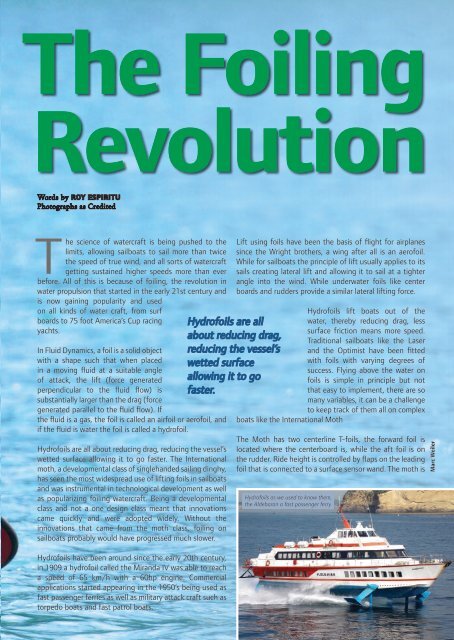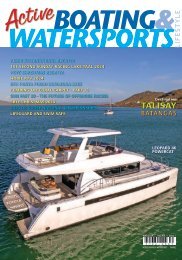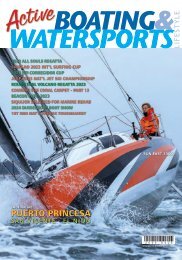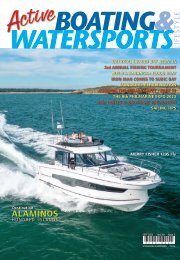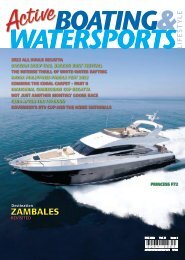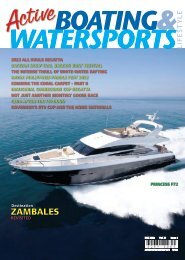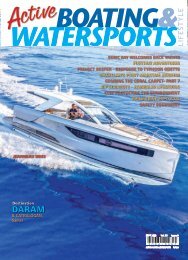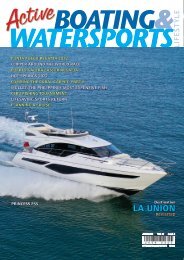June-July 2020
You also want an ePaper? Increase the reach of your titles
YUMPU automatically turns print PDFs into web optimized ePapers that Google loves.
The Foiling<br />
Revolution<br />
Words by ROY ESPIRITU<br />
Photographs as Credited<br />
The science of watercraft is being pushed to the<br />
limits, allowing sailboats to sail more than twice<br />
the speed of true wind, and all sorts of watercraft<br />
getting sustained higher speeds more than ever<br />
before. All of this is because of foiling, the revolution in<br />
water propulsion that started in the early 21st century and<br />
is now gaining popularity and used<br />
on all kinds of water craft, from surf<br />
boards to 75 foot America’s Cup racing<br />
yachts.<br />
In Fluid Dynamics, a foil is a solid object<br />
with a shape such that when placed<br />
in a moving fluid at a suitable angle<br />
of attack, the lift (force generated<br />
perpendicular to the fluid flow) is<br />
substantially larger than the drag (force<br />
generated parallel to the fluid flow). If<br />
the fluid is a gas, the foil is called an airfoil or aerofoil, and<br />
if the fluid is water the foil is called a hydrofoil.<br />
Hydrofoils are all about reducing drag, reducing the vessel’s<br />
wetted surface allowing it to go faster. The International<br />
moth, a developmental class of singlehanded sailing dinghy,<br />
has seen the most widespread use of lifting foils in sailboats<br />
and was instrumental in technological development as well<br />
as popularizing foiling watercraft. Being a developmental<br />
class and not a one design class meant that innovations<br />
came quickly and were adopted widely. Without the<br />
innovations that came from the moth class, foiling on<br />
sailboats probably would have progressed much slower.<br />
Hydrofoils are all<br />
about reducing drag,<br />
reducing the vessel’s<br />
wetted surface<br />
allowing it to go<br />
faster.<br />
Lift using foils have been the basis of flight for airplanes<br />
since the Wright brothers, a wing after all is an aerofoil.<br />
While for sailboats the principle of lift usually applies to its<br />
sails creating lateral lift and allowing it to sail at a tighter<br />
angle into the wind. While underwater foils like center<br />
boards and rudders provide a similar lateral lifting force.<br />
Hydrofoils lift boats out of the<br />
water, thereby reducing drag, less<br />
surface friction means more speed.<br />
Traditional sailboats like the Laser<br />
and the Optimist have been fitted<br />
with foils with varying degrees of<br />
success. Flying above the water on<br />
foils is simple in principle but not<br />
that easy to implement, there are so<br />
many variables, it can be a challenge<br />
to keep track of them all on complex<br />
boats like the International Moth<br />
The Moth has two centerline T-foils, the forward foil is<br />
located where the centerboard is, while the aft foil is on<br />
the rudder. Ride height is controlled by flaps on the leading<br />
foil that is connected to a surface sensor wand. The moth is<br />
Hydrofoils as we used to know them,<br />
the Aldebaran a fast passenger ferry<br />
Marc Weiler<br />
Hydrofoils have been around since the early 20th century,<br />
in 1909 a hydrofoil called the Miranda IV was able to reach<br />
a speed of 65 km/h with a 60hp engine. Commercial<br />
applications started appearing in the 1950’s being used as<br />
fast passenger ferries as well as military attack craft such as<br />
torpedo boats and fast patrol boats.<br />
21


